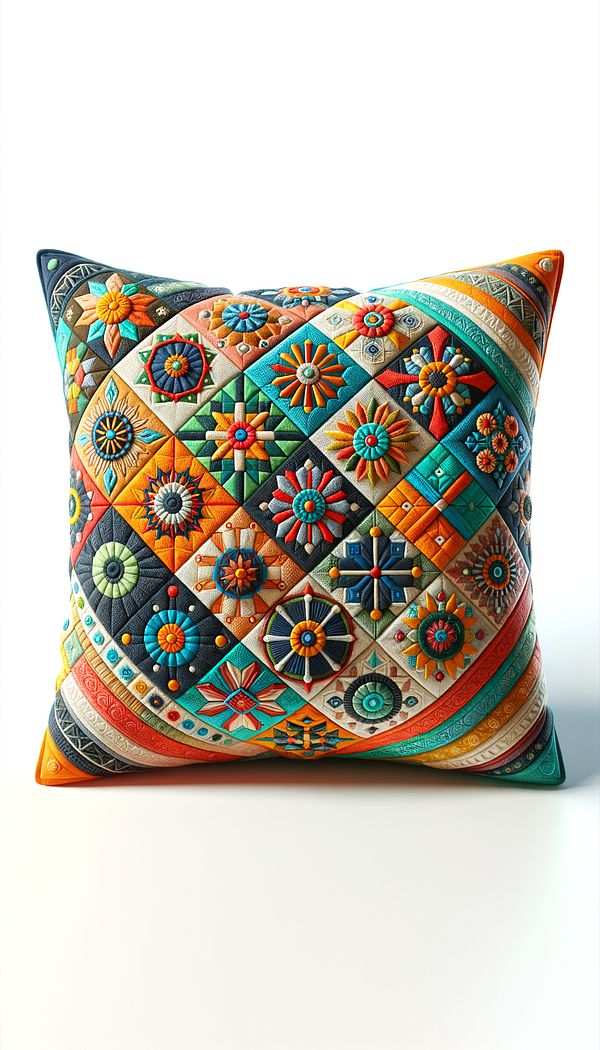What is Appliqué?
Appliqué is a decorative design technique involving the attachment of cutout pieces of material onto a larger piece to create patterns or designs.
Description
Appliqué is a fascinating and versatile decorative technique that has found its place in various forms of interior design. It involves crafting and attaching cutout pieces of fabric, leather, or other materials onto a larger piece to form patterns or representational designs. This technique can add depth, texture, and color to an otherwise plain surface, making it a popular choice for enhancing the visual appeal of textiles and upholstered furniture.
The beauty of appliqué lies in its adaptability; it can range from simple and rustic to intricate and sophisticated, depending on the materials used and the complexity of the designs. Whether employed in traditional or contemporary settings, appliqué can bring a unique personal touch to the décor, reflecting the styles and preferences of the homeowner. It is commonly seen in items such as throw pillows, quilts, wall hangings, and even drapes, adding a layer of craftsmanship and artistry that enriches the overall aesthetic of a space.
Beyond its decorative potential, appliqué also has a rich history rooted in various cultures around the world, from the textiles of ancient Egypt to the folk art of the American South. This technique has been passed down through generations, evolving over time to incorporate new materials, styles, and technologies, such as laser cutting for precision designs. By understanding and appreciating the history and versatility of appliqué, designers and enthusiasts can better appreciate the depth it brings to interior design projects.
Usage
In interior design, appliqué is most commonly applied to textiles and upholstery. For example, a designer might use appliqué to add decorative flower patterns to a plain curtain, or to create a striking geometric design on a throw pillow. It can also be found on furniture pieces, where fabric appliqués add visual interest to sofas or chairs.
FAQs
-
What materials can be used for appliqué in interior design?
A wide range of materials can be used for appliqué, including fabric, leather, felt, and even metal for more avant-garde projects. The choice of material often depends on the desired aesthetic and the item being embellished.
-
How does appliqué differ from embroidery?
While both appliqué and embroidery are decorative techniques used to enhance textiles, appliqué involves attaching cutout pieces of material onto a larger piece, whereas embroidery is the art of decorating fabric with needle and thread, creating designs with stitches directly on the material.
-
Can appliqué be used in modern interior design?
Absolutely! Appliqué is a versatile decorative technique that can be adapted to fit a wide range of design styles, including modern and contemporary interiors. Through the use of clean lines, minimalist patterns, and modern materials, appliqué can contribute to the sleek, sophisticated look characteristic of modern design.
Practical Application
When considering appliqué for your next interior design project, think about the overall aesthetic you wish to achieve and choose materials accordingly. For a more traditional look, opt for classic fabrics like cotton or silk with floral or nature-inspired designs. For contemporary spaces, consider using geometric patterns or abstract shapes with materials like leather or metallic fabrics. Remember, the key to successful appliqué is precision and attention to detail, so take your time in choosing the right patterns, materials, and placement to truly bring your design vision to life.
-
Decorative Techniques322 articles
-
Fabrication & Craftsmanship133 articles
-
Decorating Principles & Elements330 articles
-
Color & Patterns154 articles
-
Textiles & Upholstery252 articles
-
Chair RailChair rail is a type of molding fixed horizontally to the wall around the perimeter of a room.
-
AccessoriesAccessories in interior design refer to items used to enhance the aesthetic appeal and functionality of a space.
-
StoveA stove is a cooking appliance designed to cook or heat food.
-
French PolishingFrench Polishing is a wood finishing technique that produces a very high gloss surface.
-
AmoriniAmorini are decorative motifs featuring cherubic children, often depicted with wings.
